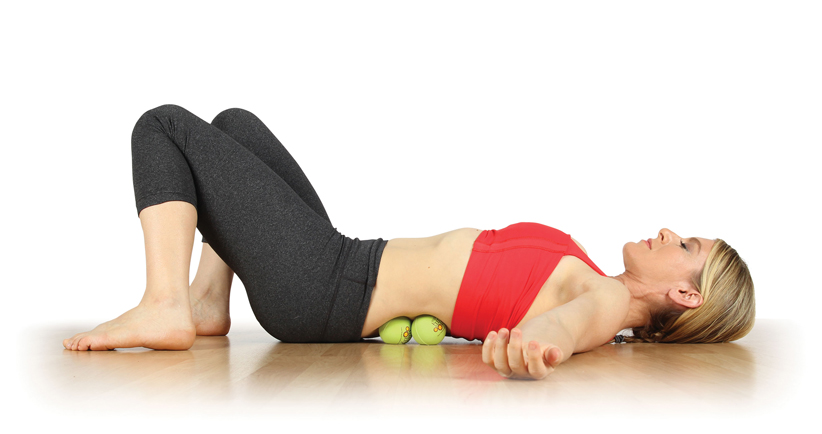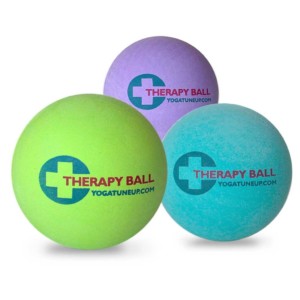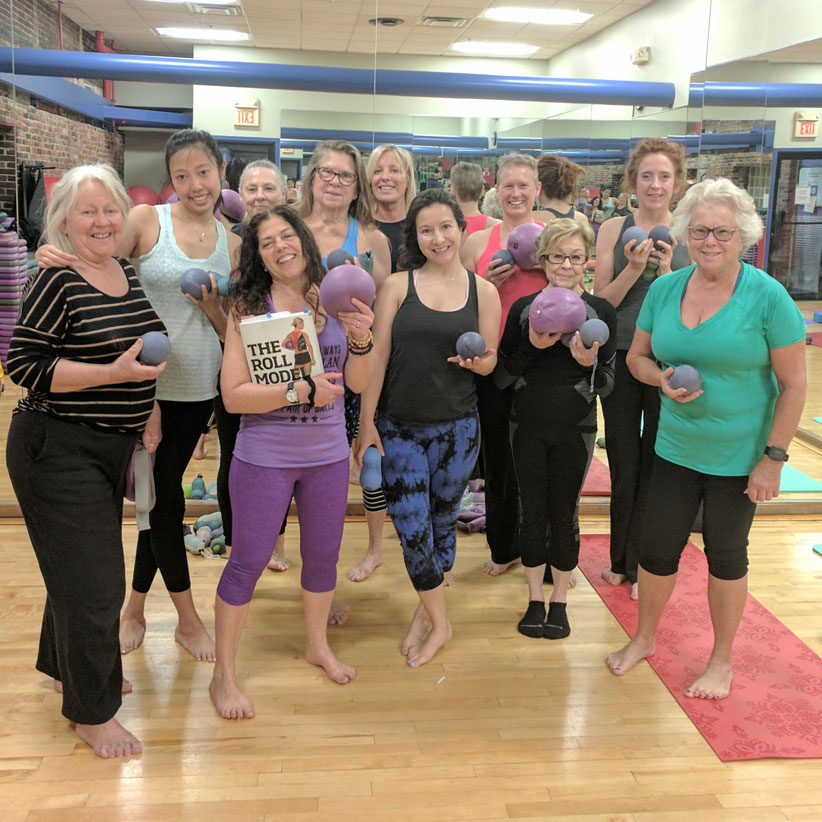As it is with most things in life, the first step towards a solution is identifying the problem. By knowing you hold tension in your right shoulder, or wherever it might be, you can begin to observe your daily habits and identify the cause.

Jill Miller, Creator of The Roll Model® Method
Upon entering into my first Roll and Release Workshop, led by Om Warrior’s Nancy Bellatoni, it felt as if I had walked into a zen, calm space in the midst of the busy North End neighborhood. Dim lighting warmed and softened the room, complemented by relaxing music. The exposed brick gave a homey feel, reflected by the large mirrors covering the remaining three walls, and created a quaint and inviting open space. Women of all ages, body types, and backgrounds attended the workshop and filled the studio with a strong, loving energy and an inspiring desire to practice self-care as they prepared to begin an exploration of their bodies and minds in this releasing practice for the next two hours. Some attendees included yoga instructors, a physical therapist, and a nurse, all seeking to expand their in-depth knowledge on the physiology of the human body. Others included yoga enthusiasts and individuals seeking to further explore their body, release tension, and practice self-care.
The class opened with a breathing check-in to observe the inhalation and exhalation capacity of our lungs, as well as to gauge our breathing control. We were asked to fill up our lungs with as much air as possible, then sip in a little more, and exhale it out until our lungs were void of breath. We then restricted the breath to one lung, then the other, the bottom of one lung, then the top of one lung, until we repeated the process on both sides. It was another calming way to begin class by soothing the nervous system of the body.
I quickly discovered after a few movements and breathing exercises that whatever expectations I had regarding the workshop came nowhere near to how wonderful the experience turned out to be. The Roll Model® Method incorporates aspects of the Yoga philosophy, flowing from movements and using the breath to overcome discomfort, and massage, adding a unique spin to it. We utilized a variety of props including yoga blocks and three yoga therapy balls of various sizes and firmness.

The workshop stressed moving slowly and gently – releasing and breathing through the pain to help loosen the fascia (a thin layer of fibrous tissue around the muscle). Nancy reminded us that holding a pose, breathing deeply, and staying there for 30-90 seconds would soften the deep, sometimes crystallized, tissue and allow the fascia to loosen. I came into the workshop expecting the exercise to feel more like a massage, and to my delight and dismay, it was, but more like a deep tissue massage. The process can be challenging; you often stumble upon areas that are quite tense, stiff, and even sore, but pushing through the discomfort allows for a greater sense of relief at the end. However, being a frequent massage-goer myself, I would argue that I left this workshop feeling more relaxed than when leaving an hour long massage. Yes, you do have to put effort in to see the effects, but by practicing this method you can go at your own pace, focus on areas that are best for you, apply your preferred pressure, and observe what feels right for your body.
After rolling out our backs, shoulders, and chest, exploring the peaks and valleys of our bodies, we eventually reached our feet. We began by digging our heels into one of the smaller yoga therapy balls, aiming to create enough pressure to flatten the ball. We then slowly worked up the arch of the foot continuing to press it forward until we arrived at the ball of the foot and began stretching one toe at a time, continuing to keep the heel of the foot firmly rooted on the mat. Finally, we placed the ball back at the heel, where we first began the exploration of our soles, and rolled the ball from the heel of the foot up to to each toe in a slow yet firm manner. Once we completed this exercise on the first foot, we were told to walk around the room with one tension-free foot and one non-rolled foot. Talk about an eye-opening experience. The contrast between the sensations in the two feet were evident upon taking the first step; the foot we had been working on felt completely relaxed and free of tension, while the other remained stiff and tight. It almost felt as if I was walking unevenly because the tension was so built up in my non-rolled foot that it seemed to add a thin layer of height.
Often times, when using the therapy balls to explore our bodies, we would discover that an area that would not seem to be a problem zone, was in fact one. Additionally, that area on the other side of your body might be tension-free, which caused for further confusion on the matter. This discovery of significantly high tension in unsuspected areas led to a question continuing to arise throughout class, “how can this hurt so much when I didn’t even know I had tension there?” As Nancy described it, there could be a variety of reasons for this hidden pain and the differences from one side to another. Perhaps it is the way you walk, stand, hold your phone. Maybe it is how you type, hold your head up, or even how you hold your dog’s leash. As it is with most things in life, the first step towards a solution is identifying the problem. By knowing you hold tension in your right shoulder, or wherever it might be, you can begin to observe your daily habits and identify the cause, which is exactly what Nancy suggested we do.
Self-examination is yet another way The Roll Model® Method mirrors conventional yoga. Attending a class or a workshop will help with numerous physical, mental, and personal benefits, but one can only truly receive these results if they reflect on their daily habits and discover how to apply what you have learned to your daily life and find the areas of your life that can be further improved. Nancy not only wanted us to leave feeling like a new person, but she made a point to have us examine the difference between both sides so we could identify the origins and attempt to prevent them in the future. Limb by limb, side by side, and area after area, we gradually worked through the tension and “rolled it out.” Every time I found a spot that was a “zing” spot, as Nancy called it, I would hold and breathe thinking that was exactly where I needed to stay to make the most difference. Then, to my surprise, I would move a quarter of an inch and find yet another. It really demonstrates the fact that self-care is a daily endeavor as opposed to one practiced once every blue moon and viewed as a treat to ourselves. Tension builds up in the body and we should learn not to push ourselves to work out harder and harder, without taking the needed time to let your muscles recover. Even something as simple as wearing heels for a night can cause the calf muscles to shorten and the shin to extend while cramping the feet. Yet, most of the time this goes unnoticed and untreated, which, over time, can cause tension to build up and even result in injury.
I found the best part about this method is its versatility; it can be practiced in any location. Dedicating as little as five minutes a day will make a significant difference. Take the therapy balls to work with you and relieve stress on a five minute break; make a habit of rolling it out when watching television or listening to music; keep a ball by your bed to release tension before going to sleep; whatever works best for you will be what drives you to continue practicing self care. This may have been the first Roll and Release Workshop I attended, but it most definitely won’t be the last. I was so satisfied with the experience that I made sure to get a set of my own therapy balls before leaving the workshop because it is truly that effective.

Image courtesy of author
At the end of class, we repeated the same breathing exercise with which we opened practice, this time noticing any differences. After releasing each area of the body, it was incredible how much it enhanced my lung capacity. I could expand and contract my lungs with much more control to significantly lengthen the breath. When doing the same exercise at the beginning of class, it was much more difficult to isolate my breath to one side, let alone one part of the lung. By ending the class the same way we had begun, it brought us back full circle. This closing exercise again demonstrated the The Roll Model® Method’s multiple benefits and its impact on the improvement of one’s pranayama practice in yoga. Except this time we were relaxed and at ease.
To learn more about The Roll Model® Method, explore the Yoga Tune Up® website, where writers are constantly sharing tactics and movements for specific areas. Or, check out LA YOGA Magazine. And, don’t miss Jill Miller’s book, The Roll Model: A Step-by-Step Guide to Erase Pain, Improve Mobility, and Live Better in Your Body (Victory Belt Publishing, 2014). Nancy Bellatoni teaches weekly classes at Om Warrior in Boston’s Financial District. Her classes can be found at omwarrior.com.
Sydney grew up in five different countries which shaped her to be a multicultural, open-minded and adventurous individual. She moved to Boston two years ago where she began her yoga training and received her Vinyasa RYT-200 yoga teacher certification. She has since collaborated with Harvard and Suffolk universities to help bring the yoga practice to an academic setting and is currently expanding her online business, Yoga with Syd. Sydney hopes her international experiences will connect with the diverse Boston community. Her ultimate goal is to introduce others to the numerous benefits of yoga and help take their practice off the mat and into their daily lives.
